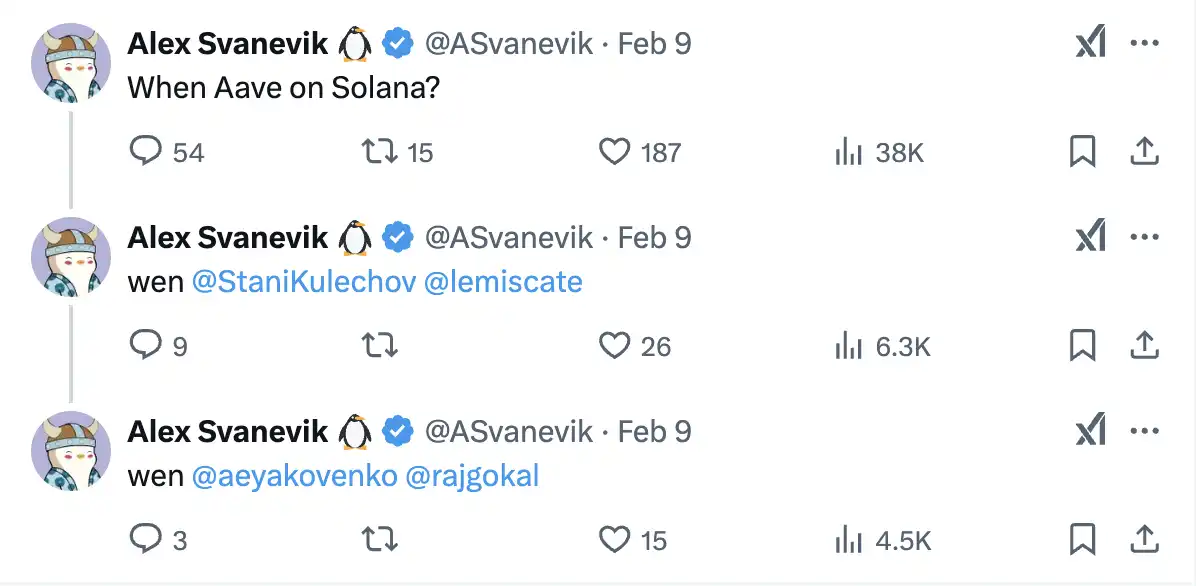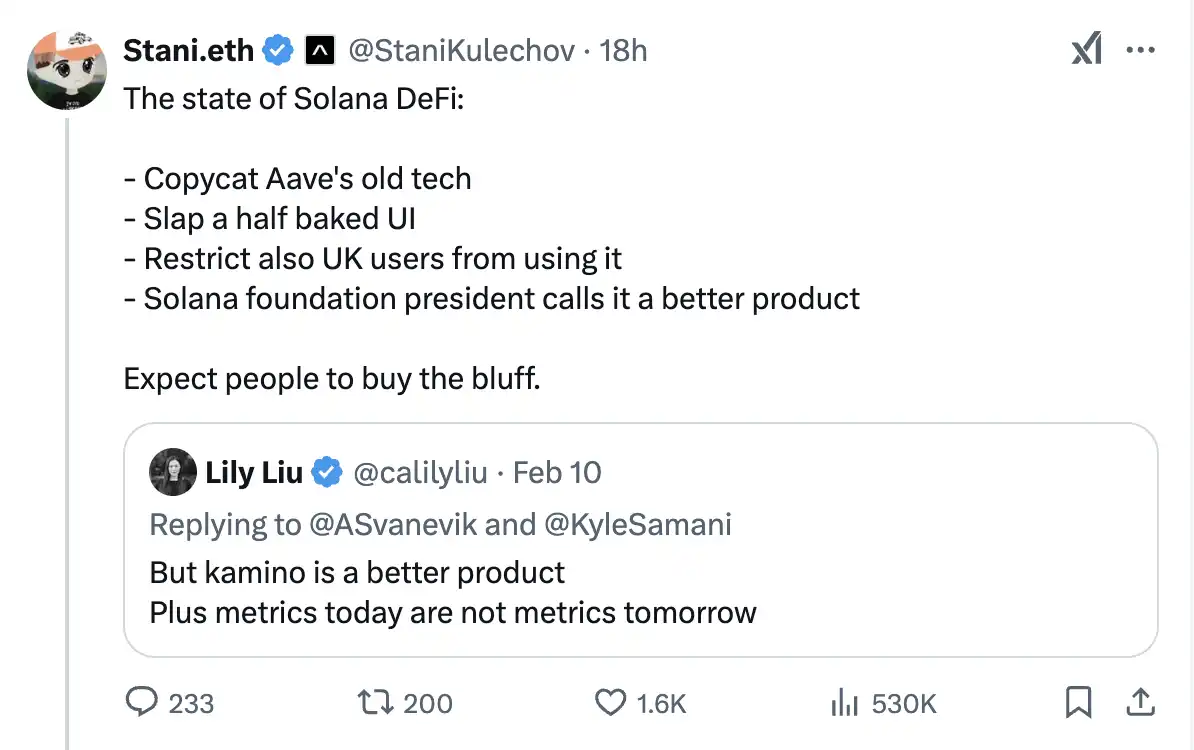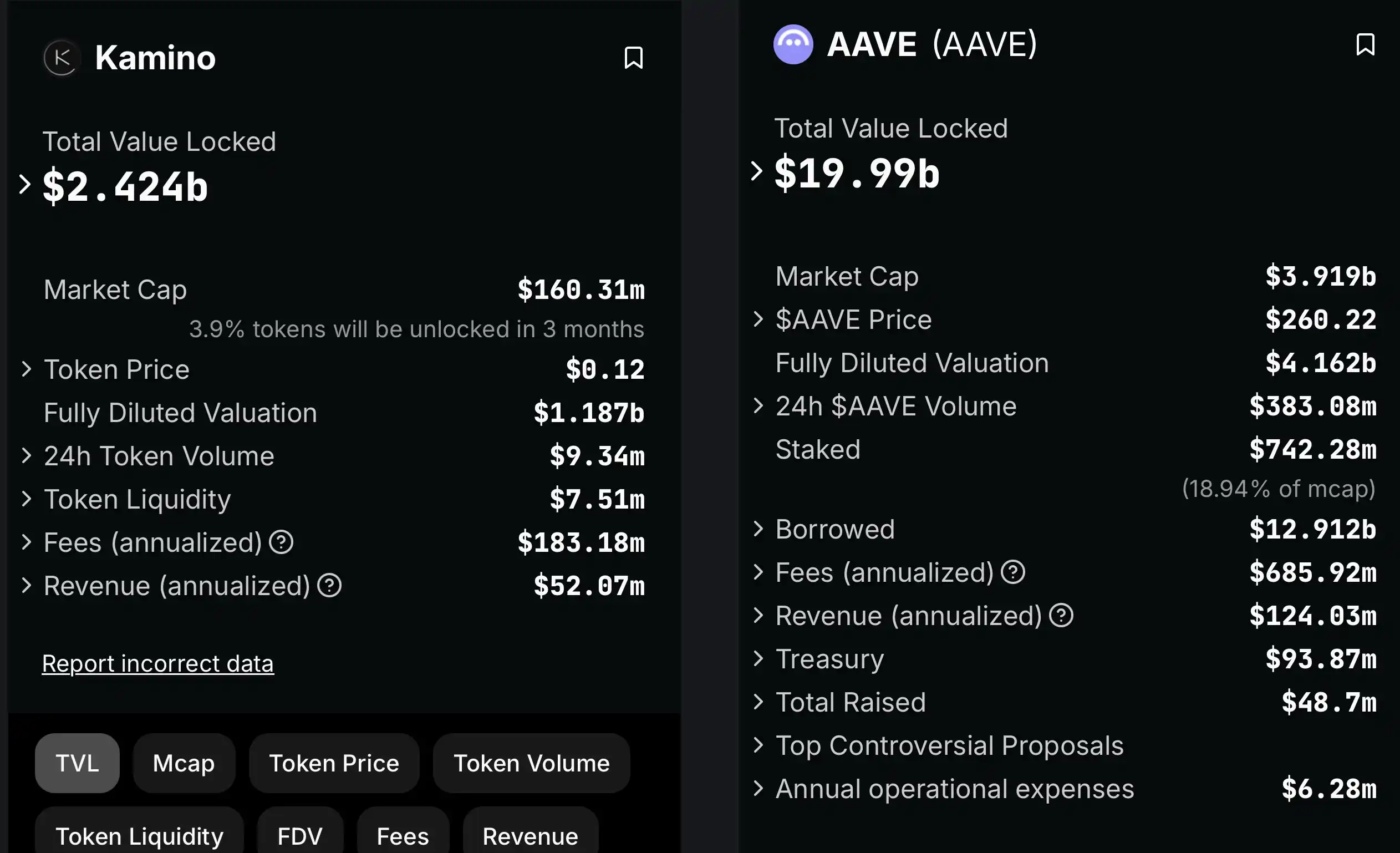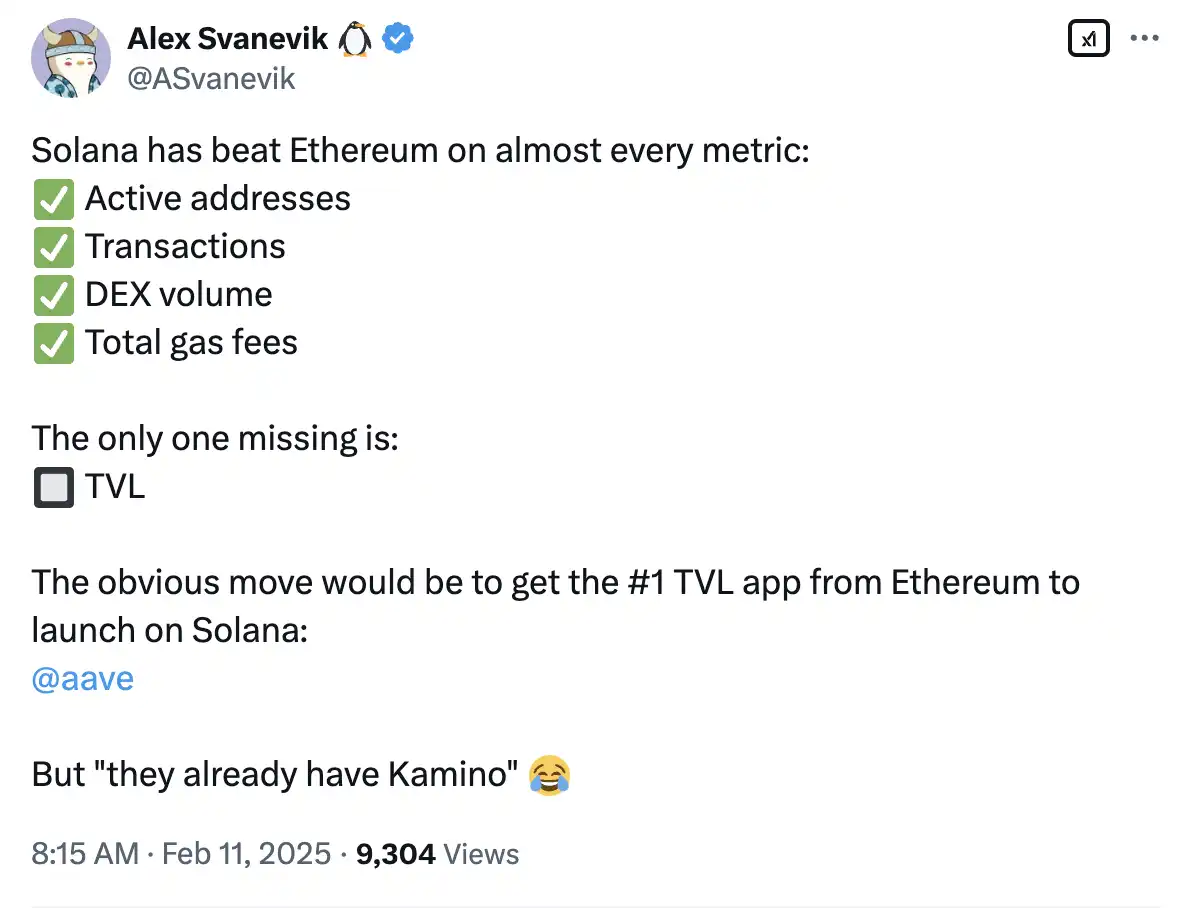The cost of trust is above everything else.
Written by: Shushu, BlockBeats
Yesterday, Virtuals Protocol announced that VIRTUAL tokens can now be traded on the Solana chain. Its official LP is now available on Meteora and has prepared for Virtual Protocol’s Launchpad on the Solana chain. At the same time, Nansen CEO Alex Svanevik tweeted when Aave would be available on Solana, and then named Aave’s team members and Solana founder.

But the comment area of this tweet has become a debate area between Solana gangs and Aave fans. Looking more broadly, this is also a battle between the market share of the Ethereum ecosystem and the Solana ecosystem in specific application areas.
A “war of words” over the loan agreement
Kyle Samani, partner of Solana’s milk king Multicoin, commented on Kamino under this tweet, a Solana Eco DeFi loan agreement intended to mean that Kamino is Solana Eco’s Aave.
Svanevik replied that Aave is 10 times larger than Kamino,”If Aave users can easily switch chains, it will be a huge TVL release.”
But Solana founder Toly and foundation chairman Lily Liu don’t think so. Lily said that Kamino’s products are better, and then said proudly,”Today’s indicators do not represent tomorrow’s performance.” Toly expressed support for a local team focused on Solana’s main network. It was wiser as a long-term investment than supporting a distracted multi-chain team, and directly eliminated the possibility of Aave coming to Solana.
Under the sharp comments of everyone in Solana Ecology, Aave and even supporters of the Ethereum Ecology are not willing to fall behind.
Aave founder Stani opened fire directly, saying that Solana DeFi’s current situation was to copy Aave’s old technology, paste a semi-finished UI, and restrict its use by British users. Although Stani was talking about Solana DeFi, people with discerning eyes knew that he was targeting Kamino, who was also involved in the loan agreement.

So, toly posted Aave and Kamino’s DeFiLlama interfaces, saying that Kamino’s TVL is 1/8 of Aave’s, but its revenue is only 1/2.5 of it. “I don’t understand why Aave is a better product. If we can’t squeeze revenue out of it, TVL is just a cost.”

Stani also pointedly replied that Kamino’s USDC reserve factor (that is, the proportion the platform withdraws from each transaction or pool of funds) is 15%, while Aave is only 10%, which means that the fee it withdraws from the user pool of funds is higher. Stani believes that this is a sign that the current competition in the Solana ecosystem is still insufficient, resulting in users having weak bargaining power when choosing the DeFi platform, charging higher fees, and ultimately paying for the bill.
Alex Svanevik, who triggered the “war of words”, added to the fire. He said that Solana had surpassed Ethereum in several key indicators, including the number of active addresses, transaction volume, DEX transaction volume and total Gas fee revenue. However, in terms of TVL, Solana still failed to surpass Ethereum. In view of this, the most direct strategy is to attract Aave, the No. 1 TVL application on Ethereum, to deploy on Solana, thereby further enhancing the competitiveness of its DeFi ecosystem.

Some people in the comment area questioned that this statement was unreasonable, because Aave’s deployment on Solana would not create TVL out of thin air. Svanevik explained that for Aave’s deployment to not bring about the growth of Solana TVL at all, the following two conditions must be met at the same time:
1. Aave’s current TVL has no funds to migrate to Solana;
2. No new TVLs have entered Aave on Solana.
However, Aave has successfully attracted US$20 billion in TVL, so Svanevik believes that Aave should be relocated to Solana, making it difficult for people to tell whether Svanevik is Ethereum maji or Solana maji for a while.
The cost of trust is above everything else
There is no doubt that Aave is the core DeFi application of the Ethereum ecosystem. Together with Uniswap, Lido, etc., it constitutes the core DeFi landscape of Ethereum. Some people in the community also question why Ethereum’s top DeFi applications miss out on Solana, an ecosystem with unlimited potential. Putting aside technical factors such as code, the reasons why an application chooses not to migrate to a new ecosystem are the same as those why choose to expand the ecosystem, and they are all to achieve incremental development.
Virtuals Protocol has expanded to Solana, with a broader user and mobility base. Aave’s decision not to go to Solana must also have considerations about the competitive landscape. Solana’s current DeFi section has become more and more complete. For loan agreements alone, there are multiple late-stage teams such as Kamino, marginfi, and Save competing for market share. Aave’s expansion costs will be higher than expected.
More importantly, Aave’s existing brand image will also be changed due to expansion. As someone in the community said,”If a person with seven to eight digits of funds wants to earn higher income than offline while ensuring safety, then ten times out of ten times, they will be recommended to go to Aave on Ethereum instead of DeFi on chains such as Solana, Tron, Celestia, etc.”
Security is the foundation of a lending product. Only when there is sufficient security audits, experience in responding to hacking attacks, and mature contract design to support, will large funds and ordinary users choose to park their assets here. Therefore, the reason why Aave has become one of the most influential lending platforms on Ethereum is inseparable from Ethereum’s long-standing developer ecosystem, security audit cases and huge and mature funding pool.
DeFi’s financial attributes determine that “the longer you run, the more sticky it becomes.” This stickiness is rooted in the deep trust in the safety and stability of product contracts. This “cost of trust” does not stop at considering the speed, performance and transaction costs of a new chain, but also includes the perfection of the infrastructure, the coverage of audit companies, the awareness of the community to potential security breaches, and the ecological response ability to make up for it in a timely manner under extreme conditions.
Related reading: “Revisiting Defi: The present and future of the most mature track for the Web3 business model”
Looking back on the development history of Ethereum DeFi in recent years, many projects have experienced major vulnerabilities or security incidents, and even cost hundreds of millions of dollars in losses. It is through repeated responses and iterations that the security barriers for Ethereum DeFi have been gradually built. The reason why Aave is so popular is that it relies on this layer of security moat, making it the first choice for users with large funds, especially institutional players. In other words, most people regard Aave as synonymous with “low risk and considerable benefits”, especially for users with millions or even tens of millions of dollars in funds. Safety and stability will always rank before incremental benefits.
In contrast, Solana, as a high-performance Layer1 blockchain, does have certain advantages in terms of transaction speed, Gas fees, etc. But from the perspective of loan agreements, the core of financial applications lies in the “risk-benefit ratio.” Speed and low costs are certainly important, but without providing enough proven security and a record of resisting attacks, such advantages are often not enough to support long-term migration of large amounts of mobility on DeFi tracks. In particular, the lending business itself has to face multiple risk factors such as liquidation, interest rate fluctuations, contract audits, and hacking; once something goes wrong, the brand image and trust accumulated by the platform over the years will be instantly disintegrated. This “trust cost” is far more expensive than the technology itself.
Looking further, even if Aave really chooses to expand to Solana, it may not bring about the so-called “increased out of thin air” TVL. Funding is profit-seeking and rational. The US$20 to 30 billion TVL accumulated by Aave on the Ethereum main network is not willing to automatically split and migrate to another chain. On the contrary, due to the huge differences in the underlying technology stacks, development languages and even community culture between chains, Aave requires a lot of time and resources to adapt and audit, which itself means extremely high expansion costs and management risks. What’s more, the existing local loan agreements on Solana are also maturing day by day, and Aave does not have the first-mover advantage of being unique.
Therefore, with the triple moat of security barriers, brand and capital scale, it may not be the wisest choice for Aave to insist on large-scale expansion to Solana. After all, in the long marathon race of DeFi, winning users ‘trust and security awareness is the most difficult core barrier to shake.
Welcome to join the official social community of Shenchao TechFlow
Telegram subscription group: www.gushiio.com/TechFlowDaily
Official Twitter account: www.gushiio.com/TechFlowPost
Twitter英文账号:https://www.gushiio.com/DeFlow_Intern



